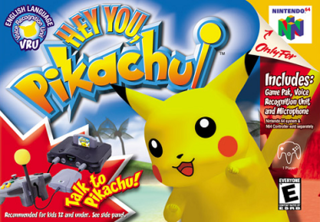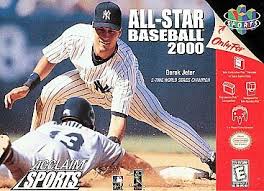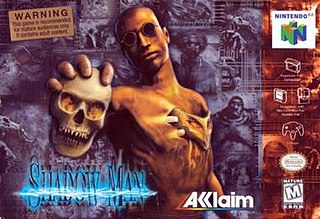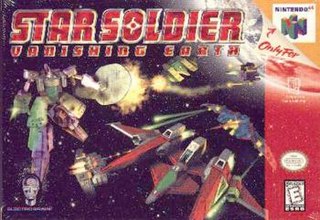
The Nintendo 64 (N64) is a home video game console developed by Nintendo. It was released on June 23, 1996, in Japan; on September 29, 1996, in North America; and on March 1, 1997, in Europe and Australia. The successor to the Super Nintendo Entertainment System, it was the last major home console to use cartridges as its primary storage format until the Nintendo Switch in 2017. It competed primarily with the Sony PlayStation and the Sega Saturn.

Mario Kart 64 is a kart racing video game developed and published by Nintendo for the Nintendo 64 (N64). It is the second main entry in the Mario Kart series and is the successor to Super Mario Kart (1992) for the Super Nintendo Entertainment System. It was released in Japan on December 14, 1996; in North America on February 10, 1997; in the United Kingdom on June 13, 1997; and in Europe on June 24, 1997. It was released for the iQue Player in China on December 25, 2003. It was released on the Wii and Wii U Virtual Console in 2007 and 2016, and on the Nintendo Switch Online + Expansion Pack on October 25, 2021.

Mario Tennis is a 2000 sports video game developed by Camelot Software Planning and published by Nintendo for the Nintendo 64. Following Mario's Tennis, it is the second game in the Mario Tennis series. The game is known for being the introduction of Luigi's arch-rival, Waluigi, and the re-introduction of Princess Daisy and Birdo.

The Super Game Boy is a peripheral that allows Game Boy cartridges to be played on a Super Nintendo Entertainment System console. Released in June 1994, it retailed for $59.99 in the United States and £49.99 in the United Kingdom. In South Korea, it is called the Super Mini Comboy and was distributed by Hyundai Electronics. A revised model, the Super Game Boy 2, was released in Japan in January 1998.

Pokémon Snap is a 1999 first-person photography game with rail shooter style gameplay mechanics developed by HAL Laboratory and published by Nintendo for the Nintendo 64. It was first released in Japan in March 1999 and was later released in July 1999 in North America and in September 2000 for PAL regions. It is a spin-off game in the Pokémon series, being one of the first console-based games for it, and featuring many Pokémon rendered for the first time in real-time 3D. The game was re-released for the Wii's Virtual Console in December 2007, for the Wii U's Virtual Console in 2016, and for the Nintendo Switch Online + Expansion Pack in June 2022.

Hey You, Pikachu! is a virtual pet Pokémon spin-off video game for the Nintendo 64 developed by Ambrella and published by Nintendo. It was released in Japan on December 12, 1998, and in North America on October 30, 2000. The player is asked to help Professor Oak test the PokéHelper, a device that lets humans communicate with Pokémon. The game is set in the Kanto region between Pewter City and Viridian City, where the player is introduced to a wild Pikachu. The player is able to communicate with a 256-word database through the Voice Recognition Unit (VRU), a Nintendo 64 hardware accessory that, when paired with a microphone, can comprehend and analyze human speech. Along with speaking with Pikachu, the VRU allows the player to move around and gather items.

WWF WrestleMania 2000 is a professional wrestling video game released in 1999 on the Nintendo 64 (N64) console. It was based on the World Wrestling Federation's annual pay-per-view, WrestleMania. Despite the fact that this game is based upon WrestleMania 2000, the game was released five months prior to the actual PPV itself, therefore resulting in the game using the stage design from the 1999 event, WrestleMania XV, instead. Released at the height of the WWF's Attitude Era, WrestleMania 2000 was the first WWF game released by THQ. The wrestling company ended its long relationship with Acclaim Entertainment after witnessing the video game success of its competitor, World Championship Wrestling (WCW), on behalf of THQ. WrestleMania 2000 shares its game engine with the Japan-only release Virtual Pro Wrestling 2: Ōdō Keishō.

NGC Magazine was a British magazine specialising in Nintendo video game consoles and software. It was first printed in 1997 and ran until 2006. It was the successor to Super Play, a magazine that ended in September 1996. Many of the staff and the style of that publication persisted at N64 Magazine. In November 2000, N64 Magazine merged with Nintendo World, a magazine that was published by the same company, Future plc. NGC Magazine ceased publication in 2006. Its successor, NGamer, was renamed Nintendo Gamer in January 2012, until publishing its final issue the following September.

All-Star Baseball 2000 is a video game developed by Iguana Entertainment and Realtime Associates and published by Acclaim Entertainment for the Game Boy Color and the Nintendo 64 in 1999.

Kirby 64: The Crystal Shards is a 2000 platform game developed by HAL Laboratory and published by Nintendo for the Nintendo 64 (N64). It is the first Kirby game to feature 3D computer graphics and follows Kirby as he attempts to reassemble a sacred crystal shattered by Dark Matter. Gameplay is viewed from a 2.5D perspective and is similar to previous Kirby titles; the player traverses levels and obtains powers by eating enemies. Kirby 64 introduces Power Combos, the ability to mix powers to create more powerful ones. In a multiplayer mode, up to four players can compete in three minigames.

Mickey's Speedway USA is a Disney racing game for the Nintendo 64 and Game Boy Color, developed by Rareware and published by Nintendo under license from Disney Interactive. It is styled after other kart racers such as Mario Kart 64 and Diddy Kong Racing, and features characters from the Mickey Mouse universe racing across the United States. It is Rare and Nintendo's second Disney-themed racing game following Mickey's Racing Adventure (1999).

Shadow Man is an action-adventure video game developed by Acclaim Studios Teesside and published by Acclaim Entertainment. It is based on the Shadow Man comic book series published by Valiant Comics. The game was announced in 1997 and was originally slated for a late 1998 release on Nintendo 64 and an early 1999 release for Microsoft Windows, but was delayed to August 31, 1999. A PlayStation version was also released on the same day. A Dreamcast version was released three months later on December 1.

California Speed is a racing video game developed and published by Atari Games and Midway Home Entertainment. The game was first released in arcades for Atari/Midway Seattle Arcade System hardware in 1998 and was ported to the Nintendo 64 in 1999 by Midway Games. The Nintendo 64 version of the game contains support for the Controller Pak and the Rumble Pak also the full support for multiplayer mode.

Ken Griffey Jr.'s Slugfest is a baseball video game developed by Angel Studios and published by Nintendo for the Nintendo 64. It was released in May 1999 only in North America. A Game Boy Color port developed by Software Creations was released in June 1999. Featuring real-life player Ken Griffey Jr., it is a sequel to Major League Baseball Featuring Ken Griffey Jr., released for the Nintendo 64, which itself was a sequel to Ken Griffey Jr. Presents Major League Baseball and Ken Griffey Jr.'s Winning Run, both released for the Super NES.

Magical Tetris Challenge is a puzzle game by Capcom for the Nintendo 64, Game Boy Color, and PlayStation. It is a version of Tetris featuring Disney characters. It is one of the few Nintendo 64 games to be entirely in 2D.

Star Soldier: Vanishing Earth is a 1998 shoot 'em up video game developed and published by Hudson Soft for the Nintendo 64, a direct sequel to Soldier Blade and is part of this Star Soldier series. There was also an arcade version released for Seta's Aleck 64, arcade hardware similar to the Nintendo 64.
Nintendo 64 accessories are first-party Nintendo hardware—and third-party hardware, licensed and unlicensed. Nintendo's first-party accessories are mainly transformative system expansions: the 64DD Internet multimedia platform, with a floppy drive, video capture and editor, game building setup, web browser, and online service; the controller plus its own expansions for storage and rumble feedback; and the RAM-boosting Expansion Pak for big improvements in graphics and gameplay. Third-party accessories include the essential game developer tools built by SGI and SN Systems on Nintendo's behalf, an unlicensed SharkWire online service, and unlicensed cheaper counterparts to first-party items. In the fifth generation of video game consoles, the Nintendo 64 had a market lifespan from 1996 to 2002.

Nintendo 64 Game Pak is the brand name of the ROM cartridges that store game data for the Nintendo 64. As with Nintendo's previous consoles, the Game Pak's design strategy was intended to achieve maximal read speed and lower console manufacturing costs through not integrating a mechanical drive, with a drawback of lower per dollar storage capacity compared to a disk. From the console's first year from late 1996 through 1997, Game Pak sizes were 4 to 12 megabytes with a typical third party retail price of US$75.99, then available in 32 megabytes in 1998, and finally 64 megabytes from 1999 onwards.
















